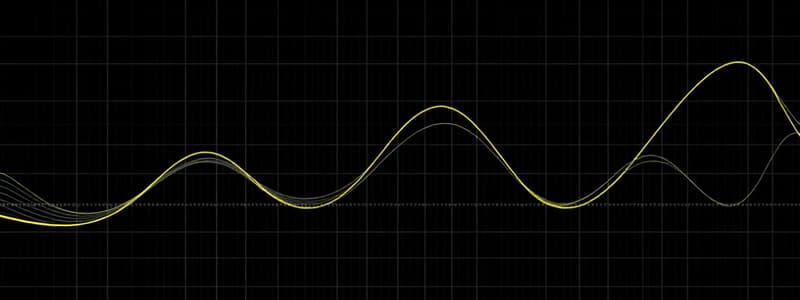Podcast
Questions and Answers
What is the primary purpose of supervised learning?
What is the primary purpose of supervised learning?
- To classify data points based on similarities
- To explore data without specific outputs
- To reinforce actions through feedback from the environment
- To predict an output variable based on input features (correct)
In the context of supervised learning, what does the pair (x(i), y(i)) represent?
In the context of supervised learning, what does the pair (x(i), y(i)) represent?
- A target variable and its maximum value
- A feature and its corresponding coefficient
- An input variable and its actual outcome (correct)
- An input variable and its predicted outcome
In a dataset for predicting housing prices, what does 'm' represent?
In a dataset for predicting housing prices, what does 'm' represent?
- The total number of houses in the market
- The average living area of the houses
- The maximum price observed
- The number of training examples in the dataset (correct)
What is usually represented by the variable 'y(i)' in supervised learning?
What is usually represented by the variable 'y(i)' in supervised learning?
Which of the following statements about supervised learning is inaccurate?
Which of the following statements about supervised learning is inaccurate?
What is the role of the training set in supervised learning?
What is the role of the training set in supervised learning?
Which of the following best describes the process of learning in supervised learning?
Which of the following best describes the process of learning in supervised learning?
What is typically plotted when analyzing a dataset on housing prices?
What is typically plotted when analyzing a dataset on housing prices?
What is the primary goal of supervised learning?
What is the primary goal of supervised learning?
In the context of the housing example, what does the hypothesis function h represent?
In the context of the housing example, what does the hypothesis function h represent?
How is a regression problem defined in supervised learning?
How is a regression problem defined in supervised learning?
Which of the following describes a classification problem in supervised learning?
Which of the following describes a classification problem in supervised learning?
What can be included as features in a supervised learning problem according to the content?
What can be included as features in a supervised learning problem according to the content?
What distinguishes supervised learning from unsupervised learning?
What distinguishes supervised learning from unsupervised learning?
What are the x’s referred to in the dataset for the housing example?
What are the x’s referred to in the dataset for the housing example?
Which of the following is a crucial step in designing a learning problem in supervised learning?
Which of the following is a crucial step in designing a learning problem in supervised learning?
What distinguishes locally weighted linear regression from parametric learning algorithms?
What distinguishes locally weighted linear regression from parametric learning algorithms?
What is the role of the bandwidth parameter τ in locally weighted linear regression?
What is the role of the bandwidth parameter τ in locally weighted linear regression?
In the context of binary classification, what do the labels 0 and 1 represent?
In the context of binary classification, what do the labels 0 and 1 represent?
What is a key characteristic of non-parametric algorithms such as locally weighted linear regression?
What is a key characteristic of non-parametric algorithms such as locally weighted linear regression?
Which of the following correctly describes the weights w(i) in locally weighted linear regression?
Which of the following correctly describes the weights w(i) in locally weighted linear regression?
What differentiates logistic regression from traditional linear regression in classification problems?
What differentiates logistic regression from traditional linear regression in classification problems?
Which formula represents the weight w(i) in generalized locally weighted linear regression when x is vector-valued?
Which formula represents the weight w(i) in generalized locally weighted linear regression when x is vector-valued?
What is the outcome when traditional linear regression is used for binary classification tasks?
What is the outcome when traditional linear regression is used for binary classification tasks?
Flashcards are hidden until you start studying
Study Notes
Supervised learning
- Supervised learning focuses on predicting output values (y) based on input variables (x)
- A training example is a pair (x, y) where x is the input and y is the output.
- A training set is a collection of m training examples.
- The goal is to learn a hypothesis function h(x) that accurately predicts y given x.
- Regression problems involve continuous output values (e.g., predicting house prices).
- Classification problems involve discrete output values (e.g., classifying email as spam or not spam).
Linear Regression
- Linear Regression is a parametric learning algorithm that uses a fixed number of parameters to represent the hypothesis.
- In the dataset example, x represents features like living area and number of bedrooms.
- The hypothesis is a linear function of the input features: h(x) = θ0 + θ1x1 + θ2x2 + ... where θi are parameters to be learned.
Locally Weighted Linear Regression
- Locally weighted linear regression uses a non-parametric approach, the weight of a training example depends on its distance to the query point.
- The weight function is defined by a bandwidth parameter τ controlling how quickly the weight falls off.
- It requires storing the whole training set for future predictions.
Classification
- Classification problems aim to predict a discrete output variable.
- Binary classification involves two classes, often labeled 0 and 1.
- The goal is to find a hypothesis function h(x) that assigns a class label to input x.
Logistic Regression
- Logistic Regression is used for binary classification.
- It introduces a sigmoid function (g(z) = 1/(1 + exp(-z))) to map the linear combination of features (θ0 + θ1x1 + θ2x2 + ...) to a value between 0 and 1 representing the probability of belonging to the positive class.
- The hypothesis is: h(x) = g(θ0 + θ1x1 + θ2x2 + ...).
Studying That Suits You
Use AI to generate personalized quizzes and flashcards to suit your learning preferences.




